
Čiobiškis Manor is a former residential manor on the confluence of Musė and Neris rivers, the southern part of Čiobiškis. The manor complex consists of the manor, farm labourers' building and stable. It is presently (2020) undergoing reconstruction.

Plungė Manor is a former Ogiński family residential manor in Plungė, Lithuania. It now harbors the Samogitian Art Museum.

Švėkšna Manor is a former residential manor in Švėkšna, Šilutė district. It was last occupied by Countess Felicija Laimė Broël-Plater.

Gelgaudiškis Manor is a former residential manor in Gelgaudiškis, Šakiai District Municipality, Lithuania.

Renavas manor is a former residential manor in Renavas village, Lithuania on the bank of Varduva river. Currently it is a museum. In the manor's park grows the thickest fir in Lithuania. The manor is valued for its original interior. Renavas Manor is one of the main tourist attractions in Mažeikiai District Municipality.
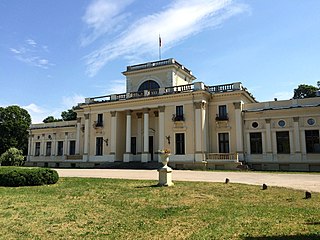
Trakų Vokė Manor is a former residential manor in Trakų Vokė. It is a monument of historicist architecture with elements of Neo-Gothic, classicism, eclectic style, located halfway between Vilnius and Trakai. The Manor was established in the end of the 19th century.

Sofija Smetonienė, was the wife of the first President of Lithuania Antanas Smetona and served as the First Lady of Lithuania from April 4, 1919, to June 19, 1920, and again from December 19, 1926, to June 15, 1940. Sofija was a member of the Chodakowski noble family.

Užutrakis Manor is a late 19th-century residential manor of the Tyszkiewicz family in Užutrakis, on the shore of Lake Galvė, opposite the famous Trakai Castle.

Telšiai Russian Orthodox St. Nicholas church is a church in Lithuania noted for its architectural style, belonging to the Russian Orthodox Diocese of Lithuania.

Church of St. Stanislaus the Bishop is a wooden Roman Catholic church in Beržoras, Plungė District Municipality, Lithuania. The church complex includes a 14-station outdoor Way of the Cross.

In 1421–1842, Alsėdžiai belonged to the Samogitian bishops, and from 1465 it became their permanent residence. The first church in Alsėdžiai was built in the 14th century. However, neither the original church nor the one that was built in the 17th century have survived to this day.
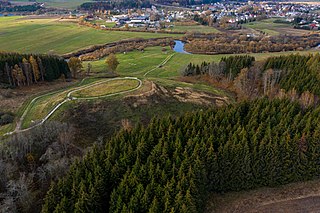
Kartena Hillfort, also called the Castle, Swede or Lūžtis Mountain, is located on the other side of the river from Kartena Town in Lithuania. The town, as well as a bend in the Minija River and the surrounding valleys are visible from the hillfort. The hillfort has been dated to the 8th to 13th centuries, while the wooden castle that once stood there was a defensive and administrative centre for the Curonians of the Ceclis lands. In the written records, Kartena is mentioned for the first time as early as 1253.
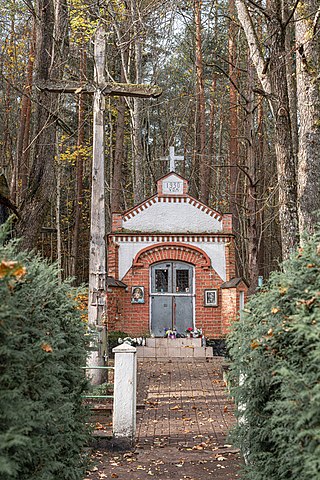
Erškėtynas Stream is located in Joskaudai Forest in Kretinga District Municipality, Lithuania between the villages of Dimitravas and Lazdininkai. A nearby chapel that was built in honour of the Mother of God is often referred to as Erškėtynas Stream Chapel.

In the 19th century, the Count Zubov family built an estate in Tarvydai Village, Lithuania, with cottages next to it for the servants of the estate. The village and the estate were named in honour of Count Dmitrij Zubov and were therefore called Dimitravas.
Romanas Chodakauskas was the Lithuanian military attaché to Berlin, a Lithuanian Diplomat in the Ukrainian People's Republic, a Colonel in the Lithuanian Military Court, and brother of Sofija Smetonienė, Tadas Chodakauskas and Jadvyga Tūbelienė. Romanas was a member of the Chodakowski noble family.
Tadas Chodakauskas was the long-standing mayor of Panevėžys, Lithuania (1925–1940).
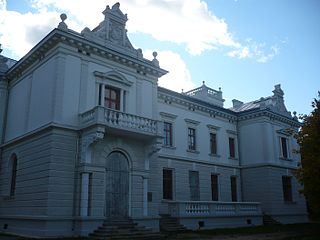
Vilkėnas Manor is a former residential manor in Vilkėnas Village, Švėkšna, Lithuania.

Jan Chryzostom Piłsudski (1760–1837), was a Lithuania nobleman and landowner, Chamberlain of the Duchy of Samogitia, Marshal of the Nobility for the District of Telšiai, member of The Great Sejm, sub-prefect of the Provisional Government of Lithuania for the area of Telšiai and ancestor of Romanas Chodakauskas, Sofija Smetonienė, Tadas Chodakauskas and Jadvyga Tūbelienė.
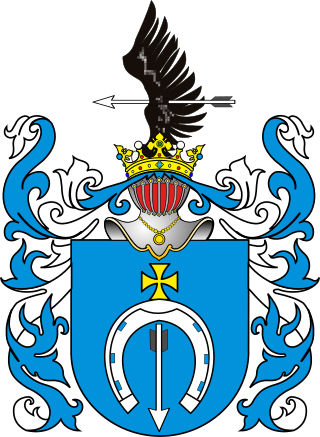
The Chodakowski family is a Polish-Lithuanian noble family. They originated in Mazovia in the Kingdom of Poland. The family was known to be in the Grand Duchy of Lithuania since the 16th century. They use the Dołęga Coat of Arms.
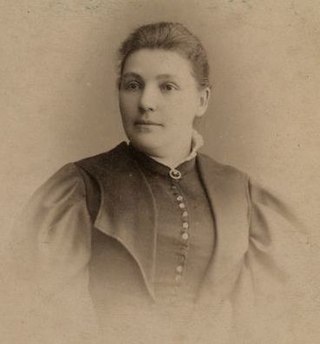
Sofija Zubovienė née Bilevičiūtė was a Lithuanian noblewoman. Together with her husband count Vladimir Zubov, she established and maintained six primary schools for children of manor workers and peasants in their estates near Šiauliai.





















